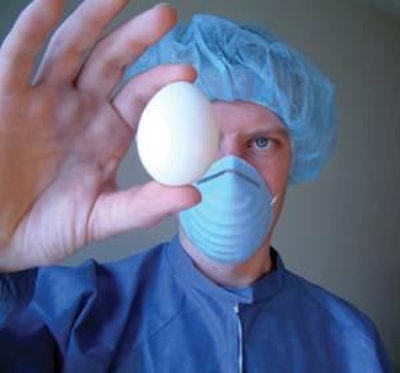
The goal of any Salmonella control program is to create an environment that makes it hard for Salmonella to grow, according to Dr. Angela Shaw, assistant professor, food science and human nutrition, Iowa State University. Her specialty has been helping food companies develop Salmonella control plans, and she said that making the environment inhospitable to Salmonella isn’t easy.
Speaking at the Midwest Poultry Federation Convention, Shaw said that many of her onsite visits occur after a facility has tested positive for Salmonella, and she tries to figure out how to get rid of it. She said that this job is complicated by the fact the Salmonella spreads easily and can survive on many types of surfaces. “If you find Salmonella in one place, then you will probably find it all over your barn,” she said.
Salmonella facts
Shaw said that Salmonella has 40 different virulence factors, and other bacteria have many fewer; E. coli, for instance, has only five. She broke types of Salmonella into three main groups: those that infect humans only, host adapted serovars and unadapted serovars. The unadapted serovars can be some of the most difficult to deal with, according to Shaw.
Salmonella typhimurium and Salmonella enteritidis are both adapted to humans. People can be carriers of Salmonella enteritidis and be asymptomatic, so farm and hatchery employees are a potential source of Salmonella enteritidis contamination for layers. Shaw said that approximately 40 percent of the general human population is carrying Salmonella without knowing it. She cited the example of a university colleague who was asymptomatic for Salmonella and had to be particularly careful when visiting food plants.
Salmonella is ubiquitous
Salmonella can be found in poultry house dust, rodents, shipping containers, contaminated feed, polluted water and in the digestive tract of just about any animal. Since Salmonella is found in the digestive tract of animals, it likes warm, wet environments. Summertime is the peak time for Salmonella in the environment.
Salmonella grows at a pH of 6.5-7.5, but it can survive at a pH of 4.5-9.5. Salmonella is a facultative anaerobe that can survive in low oxygen environments, so it can survive in the middle of a manure pile as long as it doesn’t go through a heat cycle.
Wet environments are ideal for Salmonella, and it is more heat- and acid-resistant at high humidity levels. Growth of Salmonella is inhibited at 3-4 percent salt, and Shaw said that salting manure piles in the pit can help control Salmonella in the layer house.
Starting Salmonella-free
It is essential to start a new flock in a Salmonella-free house, and this means thorough cleaning and disinfection between flocks. Shaw said that you can’t sanitize and clean in the same step; you have to clean first, and cleaning means removing all visible organic materials. Salmonella can adhere to hard surfaces; wood is really bad for harboring Salmonella. You want to steer clear of having exposed wood in your houses if you can.
Sanitize all house surfaces after cleaning. Shaw said that you need to rotate sanitizers by category, not by brand. Even if you only clean out once a year, you still need to rotate sanitizers. She said that peroxide and quaternary ammonia-based sanitizers work best. Your barn cleaning and sanitizing isn’t finished until the house is dry. Shaw said that environmental samples should be taken before and after cleaning and sanitizing to make sure that you got the job done.
Chicks and pullets
There has been demonstrated transovarian transmission of some Salmonella serovars, particularly Salmonella enteritidis. Your pullet chicks need to come from a Salmonella-free source. If you purchase pullets, these have to be free of Salmonella before you place them in the layer house. Once in the house, Shaw said that it is important to minimize stress on the flock. Employee turnover in the layer barn can create stress for the flock, so keeping the same caretakers is beneficial.
Keeping inputs clean
Layers need clean air, feed and water, and each of these can be contaminated with Salmonella. Shaw suggested testing incoming feed ingredients for Salmonella as well as testing finished feed. Water for the birds can be tested for Salmonella as well. If any bedding is used in the layer or pullet house, Shaw said to make certain that it is Salmonella-free.
Dust particles in the air can carry Salmonella. Air brought into the house by ventilation fans can be a source of Salmonella. Shaw asked, “What are you bringing in from other farms?” Salmonella on dust particles has been shown experimentally to travel 12.5-15.5 miles. Dust generated within the poultry house can be a source of Salmonella contamination for birds. Shaw said that high dust environments in the poultry house are highly correlated with Salmonella contamination of the birds. It is important to control dust; sometimes it is a balancing act to maintain enough moisture to keep dust down but not have so much that you promote Salmonella growth.
Salmonella vectors
Shaw considers rodents to be the number-one vector for bringing Salmonella into the poultry house, and rodent control is very important. People also carry Salmonella into the layer house. She said that clean clothing and boots for workers are essential; clothing is right behind rodents as a Salmonella vector.
Shaw said it is critical to make sure your employees are not around animals at home and don’t have side jobs with animals. She asked, “Do you test your employees for Salmonella? If they are sick with diarrhea, do you make them go home?” She said that some food companies require rectal swabs of employees to see if they are Salmonella carriers.
Vehicle sanitation is important for Salmonella control, according to Shaw. She said that 10-20 percent of soil samples taken in Iowa are positive for Salmonella enteritidis. Do you sanitize vehicle tires before you allow them on the farm? She said she has found Salmonella enteritidis-positive swabs samples taken of vehicle tires.


















